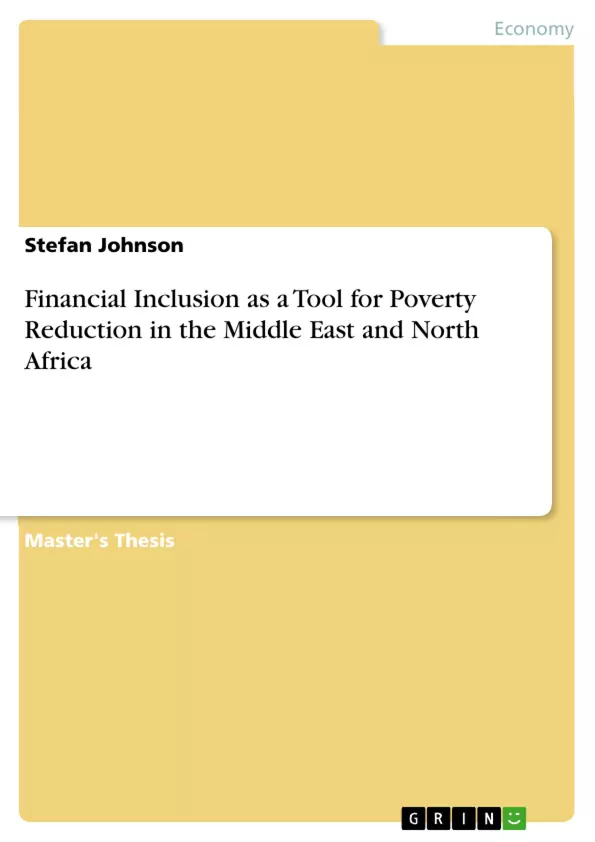This paper observes the relationship between multiple variables in order to determine whether Financial Inclusion can be used as a tool for poverty reduction in the Middle East and North Africa. There are many reports that identify this to be function to something very likely as a tool around the world; however, there has been limited work regarding financial inclusion and the Middle East and North Africa. Through qualitative and quantitative research, this paper examines the possibility of this theory working in MENA. Wide income disparities, combined with government corruption, religious dispositions, and an overall lack of money are contributing barriers to the unbanked. These factors greatly limit the use of this tool until other issues are tackled and governments commit to more policies that will be conducive to growth; banks must be more open to lending; and people will have to become more financially literate.
The World Bank, Gallup, the IMF, and various authors, in addition to the World Bank FINDEX dataset are used to reference information conceded by well-respected authors in the financial-, development-, and in the government sector. Although there seems to be a great deal of promise with the concept of Financial Inclusion as a Tool for Poverty Reduction world wide, it seems to be very limited in MENA, in the poverty-stricken nations. Algeria, Egypt, Iraq, Jordan, Lebanon, Morocco, and Yemen are observed in the report. Generally, there are barriers preventing the implementation of inclusiveness, which will prevent the advancement of poverty alleviation. More government commitment is required.
Inhaltsverzeichnis (Table of Contents)
- ABSTRACT
- ACKNOWLEDGEMENTS
- LIST OF ABBREVIATIONS
- LIST OF TABLES
- LIST OF FIGURES
- DEFINITIONS
- CHAPTER 1 INTRODUCTION
- CHAPTER 2 BACKGROUND
- 2.1 PEOPLE'S DEMOCRATIC REPUBLIC OF ALGERIA
- 2.2 ARAB REPUBLIC OF EGYPT
- 2.3 REPUBLIC OF IRAQ
- 2.4 HASHEMITE KINGDOM OF JORDAN
- 2.5 LEBANESE REPUBLIC
- 2.6 KINGDOM OF MOROCCO
- 2.7 REPUBLIC OF YEMEN
- CHAPTER 3 LITERATURE REVIEW
- CHAPTER 4 METHODOLOGY
- 4.1 APPROACH
- 4.2 DATA GATHERING METHOD
- 4.3 DATABASE OF STUDY
- 4.4 VALIDITY OF DATA
- 4.5 ORIGINALITY AND LIMITATIONS
- 4.6 SUMMARY
- CHAPTER 5 CORRELATIVE TEST HYPOTHESES
- CHAPTER 6 RESULTS
- 6.1 QUALITATIVE DATA RESULTS
- 6.2 QUANTITATIVE DATA RESULTS
- 6.2.1 HYPOTHESES RESULTS
- 6.3 SUMMARY OF RESULTS
Zielsetzung und Themenschwerpunkte (Objectives and Key Themes)
This dissertation aims to explore the relationship between financial inclusion and poverty reduction in the Middle East and North Africa (MENA) region. It investigates whether financial inclusion can effectively serve as a tool for alleviating poverty in this specific context.
- The role of financial inclusion in promoting economic development and poverty reduction in MENA.
- Obstacles and challenges to financial inclusion in the region, including factors like income disparities, government corruption, and religious attitudes.
- The impact of financial literacy on individuals' ability to benefit from financial services.
- The importance of government policy and bank participation in promoting financial inclusion.
- The potential effectiveness of financial inclusion as a poverty reduction tool in MENA compared to other regions.
Zusammenfassung der Kapitel (Chapter Summaries)
The dissertation begins with an introduction outlining the research question and the significance of the study. Chapter 2 provides a comprehensive overview of the MENA region, focusing on key socio-economic characteristics relevant to financial inclusion and poverty.
Chapter 3 delves into a comprehensive review of existing literature, examining previous research on financial inclusion and poverty reduction in both developed and developing countries. This chapter establishes a foundation for the research and highlights the existing knowledge base.
Chapter 4 outlines the research methodology employed in the dissertation. The chapter details the data gathering methods, the database used, and the validation of the data. This section also discusses the study's originality and limitations.
Chapter 5 presents the hypotheses tested in the research, exploring the relationship between financial inclusion and poverty reduction in the selected MENA countries. The chapter lays out the theoretical framework for analyzing the collected data.
Chapter 6 presents the results of the qualitative and quantitative analyses conducted. The chapter analyzes the data in the context of the research hypotheses, exploring the findings in detail.
While the conclusion (Chapter 7) is not included in this preview, it is likely to draw upon the findings of the study to discuss the overall implications of financial inclusion for poverty reduction in MENA. The chapter may also offer recommendations for policymakers and financial institutions based on the research findings.
Schlüsselwörter (Keywords)
This dissertation explores the intersection of financial inclusion, poverty reduction, and development in the Middle East and North Africa (MENA) region. Key terms and concepts include: financial inclusion, poverty reduction, MENA region, financial literacy, government policy, bank participation, income inequality, corruption, and religious attitudes.
- Quote paper
- Stefan Johnson (Author), 2014, Financial Inclusion as a Tool for Poverty Reduction in the Middle East and North Africa, Munich, GRIN Verlag, https://www.grin.com/document/334694



